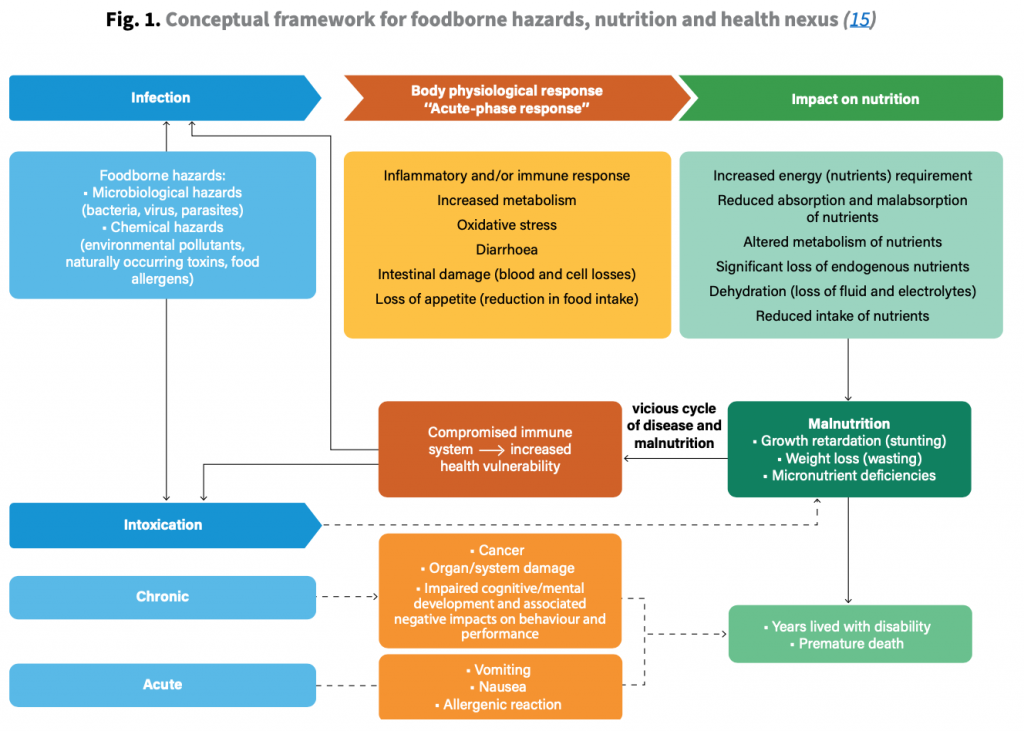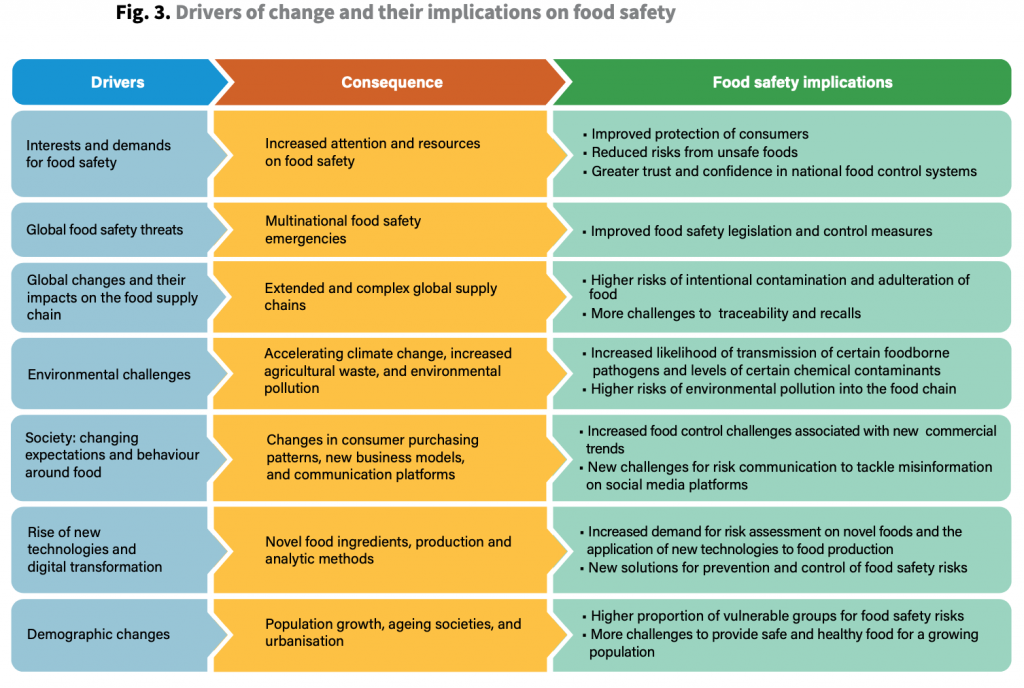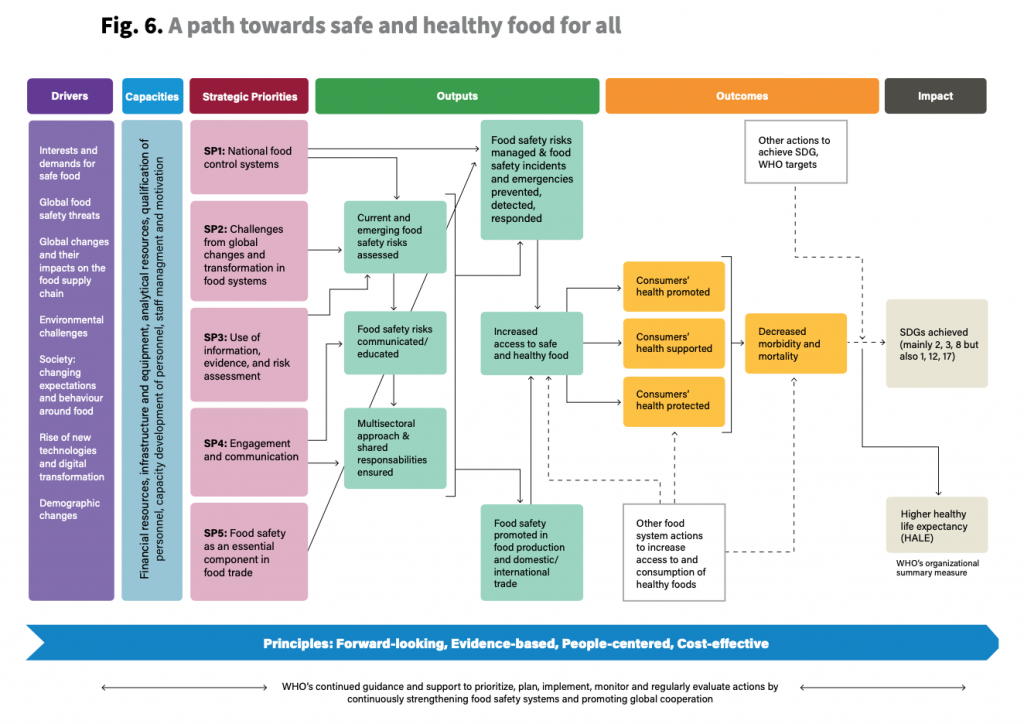Introduction WHO Global Strategy for Food Safety
Food Safety in a global setting is an important topic, nonetheless, it is 20 years ago since the last Global Food Strategy for food safety by the WHO was written. Therefore it was time for a renewal, which was recently launched and supported by a Technical Advisory Group (TAG). During the launch, it got clear that Global Food Safety:
– is at threat,
– there are new technologies and
– there is huge interest and demand.
The following article talks about the future goals and the current outcomes from the WHO perspective regarding this topic, as well as comparing it to QAssurance work.
Why is an update of the Global Strategy for Food Safety needed?
One of the main factors affecting people’s health is safe food. A fundamental human right is the availability of food that is safe, nourishing, and healthy. Governments must assure that food on the market complies with safety requirements to protect this right. Given how linked the globe is today, and how quickly food systems are evolving, this endeavour is challenging. Our consumption, production, management and delivery of Food have changed. These elements necessitate a novel global strategy for enhancing food safety that strives to improve both national and international cooperation and national food safety systems. Not to forget, food safety is every person’s responsibility, and every stakeholder has to play a role in complying with a food-safe world.
By offering a broad vision and strategic priorities for collective global action in food safety, this strategy enhances the work of Member States and the global health community. To considerably lessen the burden of foodborne diseases, it highlights the crucial role that this industry plays in public health and the necessity for improved worldwide cooperation along the entire food and feed chain. This plan is also anticipated to help with the execution of pledges made to improve food safety at the UN Food Systems Summit.
Unsafe food can lead to various and more than 200 diseases ranging from acute or chronic illnesses, including diarrhoea, cancer, permanent disability, or even death. It contains dangerous concentrations of bacteria, viruses, parasites, chemicals, or physical agents.
For food systems to produce beneficial health outcomes, nutrition and food safety must be prioritised. For growth, health, and well-being, food must be nutritious, readily available, easily accessible, safe, and culturally acceptable. A vicious cycle of sickness, hunger, and disability is fueled by unsafe food and disproportionately affects vulnerable populations. Simply expressed, nutrition and food security are mutually exclusive concepts. The intimate connections between food safety, foodborne diseases and their effects on nutrition and human health at the individual level are shown in Fig. 1.

Therefore, it is now more important than ever to create global standards for food safety that can be used both domestically and in international trade. Failure to assure compliance with rules and standards would result in financial losses as well as a loss of faith in business and the assurances given by government authorities without prevention-oriented food safety risk management systems. Producers who do not ensure compliance run the risk of being shut out of high-value markets, which would cost them money in rejected exports and hurt their brand’s reputation. Lack of attention to food safety harms the development and modernisation of domestic food markets, which reduces income and employment opportunities.
Food Safety drivers of change
Interest and demands for safe food
The need to improve national food safety systems is becoming more widely recognised to preserve public health, build consumer confidence in the food supply, and enable international trade in food. To address present and future difficulties in food safety, stakeholders are putting pressure on national governments to take a strong leadership position. While acknowledging that Food Business Operators have the primary duty to produce safe food, they should provide necessary financial, educational, and technical resources at the appropriate levels for developing systems to ensure food safety across the whole food and feed chain. Unsafe food erodes the public’s trust in the nation’s food safety system and the competent authorities in charge.
Global food safety threats
Food systems, food supply chains, and food safety legislation have changed on a national and international level as a result of numerous food safety incidents and catastrophes. For instance, the multi-nation epidemics of Escherichia coli (STEC) that produce the Shiga toxin and hepatitis A linked to contaminated seed sprouts and frozen berries, respectively. All of the aforementioned instances led to modifications in food systems and laws. Furthermore, changes in agricultural practice, enhanced intersectoral collaboration, surveillance and data sharing, and investigation of regulatory requirements for the future are already happening as a result of a global public health focus on antimicrobial resistance and recognition of the potential of the food and agricultural production system as a contributing factor.
Global changes and their impact on the food supply chain
Global patterns in food movements are a result of changes in supply and production costs that are continuously experienced by interconnected national food systems and food value chains. For instance, the introduction of brand-new, expensive items to the market might serve as a significant inducement for food fraud. Food fraud mostly affects food quality, but it can also compromise food safety if it uses harmful products or substitutes. Extended and complicated global food supply chains, as well as food ingredients, present new difficulties for food authenticity and traceability and raise the possibility of intentional contamination.
Environmental challenges
Real problems are presented by climate change, which is also a significant factor in the development of new and current food safety hazards. Our food systems are significantly impacted by climate change, which results in ocean warming and acidification, severe droughts, wildfires, changing precipitation patterns, melting glaciers, increasing sea levels, and extreme weather events.
Fresh fruits and vegetables are more commonly implicated in food safety incidents involving microbiological concerns globally than other food categories.
Food insecurity is made worse by food waste and losses caused by unhealthy food, which also put a strain on waste management systems. Over 17% of food is wasted globally, and this waste is linked to up to 10% of greenhouse gas emissions.
Society: Changing expectations and behaviour around food
Social megatrends are a frequent occurrence in the linked world of today. Consumer preferences, buying patterns, and expectations are changing quickly, which is affecting how some foods are produced and distributed (e.g. demand in some populations for organic, fresh and less processed foods and demand for alternative protein sources). Additionally, in order to satisfy customer demands, new business models, such as e-commerce and meal deliveries, are emerging. Social media platforms offer fresh opportunities for risk communication and education about food safety from a communication standpoint. The inability to discriminate between accurate and false information, however, can cause consumers to lose faith in the food industry and in governments.
Rise of new technologies and digital transformation
Food and agricultural innovation are advancing at an accelerated rate, benefiting food production economically and providing customers with more options and less food waste. Applications of nanotechnology in the food industry may result in nutrient enhancements, bioactive delivery methods, and novel food packaging materials that could lengthen the shelf life of goods. Some cutting-edge technologies may be unaffordable for lower-income nations due to the high costs associated with their research and development, which would result in an equity gap in innovation and the capacity to identify risks.
Food systems are undergoing rapid change as a result of digital innovation and transformation in the context of big data and analytics, artificial intelligence, and the internet of things (IoT).
Demographic changes
Population ageing and growth, and urbanisation are part of demographic changes and food systems drivers of change. Given the expanding global population and shifting sociodemographics, food safety is of utmost concern. Identifying at-risk population groups and creating tailored risk management plans for these groups while widely disseminating the value of safe and healthy diets is a problem for national food safety systems.
The accessibility of safe food in urban settings, especially in low and middle-income countries is further threatened by the lack of essential basic infrastructure, such as distribution services, hygiene and sanitation facilities, and food storage equipment needed for food safety. These problems underscore the necessity for responsible authorities and other national entities in charge of food safety to create backup plans for handling food safety emergencies.

The Global Strategy for Food Safety was created to help Member States prioritise, plan, carry out, oversee, and routinely assess actions aimed at reducing the burden of foodborne diseases by continually enhancing food safety systems and encouraging international cooperation.
The strategy’s objective is for everyone, everywhere to eat secure, wholesome food, thereby easing the burden of foodborne diseases. This plan equips participants with the means to improve domestic food safety systems and cooperate with international partners. Therefore a theory of change was created to reach their just mentioned aim and vision.

Relation to QAssurance
Emphasising the need for a food safety system shows how essential the work of QAssurance is and looking closer iMIS Food could help to tackle some of the problems. In the articles, drivers of change in global food threats were mentioned especially looking at diseases. Here QAssurance provides information about diseases and hazards. Same as for the next driver, global changes and their impact on the food supply chain, information can be provided, such as consulting about food fraud, training or the iMIS Food system, which has a traceability component. Same as for the drivers of change iMIS can be supportive in achieving the strategic priorities too.
Sources
WHO.2022. WHO global strategy for food safety 2022-2030: towards stronger food safety systems and global cooperation. Geneva: https://www.who.int/publications/i/item/9789240057685
Related articles to WHO Global Strategy for Food Safety 2022-2030
Many customers and visitors to this page 'WHO Global Strategy for Food Safety 2022-2030' also viewed the articles and manuals listed below:
